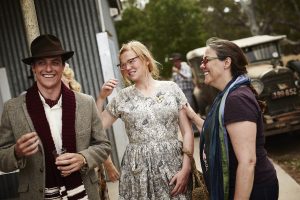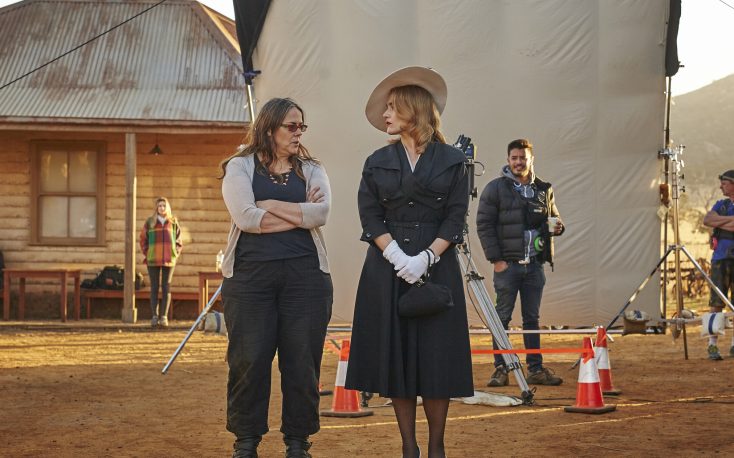
(l to r) James Mackay, Sarah Snook, and Director Jocelyn Moorhouse on the set of THE DRESSMAKER. ©Broad Green Pictures / Amazon Studios. CR: Ben King.
By ANGELA DAWSON
Front Row Features
HOLLYWOOD—After scooping up four of the top prizes at the Australian Film Critics Association Awards earlier this year, “The Dressmaker,” starring Oscar winner Kate Winslet, is ready to make its debut in the U.S.
Aussie film director Jocelyn Moorhouse (“Proof,” “Unconditional Love”) directs the quirky comedy about a successful seamstress who returns to her parochial hometown to try to recall the horrible event that drove her out years earlier, which she adapted from Rosalie Ham’s novel, along with her writer-director husband P.J. Hogan.
Winslet leads an all-star Australian cast that includes Hugo Weaving (“The Matrix” films), Oscar nominee Judy Davis (“Husbands and Wives,” “A Passage to India”) and Liam Hemsworth (“The Hunger Games” films).
As Tilly, Winslet is a gifted seamstress who left her rural home years earlier after a tragic event. The problem is she can’t recall exactly what happened, except that she was blamed for the incident. She returns to the home of her dying mother (Davis) in hopes of piecing together the events of long ago and perhaps exacting a little revenge of the judgmental townspeople by creating couture fashions for other outcasts in the community. She acquires assistance in pursuit of the truth from a closeted cross-dressing local policeman (Weaving).
Speaking by phone, Moorhouse talked about making the comedy, assembling a strong cast and those incredible one-of-a-kind costumes that Winslet’s character creates and wears.
Q: What was it that drew you to this project?
Moorhouse: The book. It has so many more storylines in it. I had to cut a lot. The book was kind of a revelation, when I read it. It was so Australian. It reminded me a little bit of (Australian Nobel prizewinner author) Patrick White but so much ore lighthearted. It was really the portraits of these really extreme Australian characters. On the other hand, there was really a feminine sensibility about it. There was a feminine perception and attitude toward the understanding of the characters, which I found intriguing.
I loved the fact that the central story was really about a mother and daughter finding their way back to each other, after being estranged for so long. I was deeply moved by that. At the time, my mother was very ill and I was becoming more and more aware of the fact that she wasn’t going to be around much longer. She and I had been very close. So I think the whole mother-daughter central storyline is what drew me into wanting to do this film.
Q: It was interesting that Kate’s character had this expertise that got her out of this small, and small-minded, town.
Moorhouse: It’s really fascinating what she can do. What I would say to everybody is that she’s kind of like a witch or fairy godmother. She has this magical ability to transform her clients, like Cinderella and her fairy godmother. She goes from rags to looking like a fairy princess.
The whole film is sort of like a dark fairy tale—fairy tale meets spaghetti western. I could go on and on about spaghetti westerns because they’re actually fairy tales too.
The character of Gertrude (one of the locals that Tilly transforms with with a dress) is definitely a Cinderella. She goes from being dressed in what could pass for a sack of potatoes to looking like a movie star, with a glittering princess dress. That is because Tilly (Winslet’s character) is almost magical.
Q: Can you talk about the costume designers you had on this and getting the 1950s style across in the film?
Moorhouse: When I started doing research (on the clothes) before we had a costume designer onboard, I became obsessed with going through old copies of Vogue. I was going through the Vogue archives, which actually was quite expensive to subscribe to. What it gave me access to is every issue of Vogue from the very beginning of its publication to now. So I could study every issue in the 1950s and see who they were talking about and see the emergence of Christian Dior. Chanel already was established by the ‘50s but it burst onto the scene and changed everything. There also was, of course, (French fashion house) Balmain, Balenciaga, Jacques Fath—just fabulous designers. I just started thinking, “I wish we could still wear clothes like this.” I just couldn’t stop collecting images. I picked out about 3,000 images even though I could only have about 32 costume changes for Kate. She still has quite a few costume changes. I think we narrowed it down to about 15.
By the time my poor costume designer (Marion Boyce) got on board, I had hundreds of images to give her. She said to me, “These dresses that Tilly creates are kind of like characters.” Each dress not only had to look pretty, it had to serve a purpose within the story, and the character development purpose. Once we narrowed it down and cast the characters and had real actresses with whom to base (the costumes), we had to make sure the outfits suited them and the colors were right.
When Kate was cast, she asked if she could have Margot Wilson create her costumes because she’d worked with Margot before and knew Margot could make her look incredibly sexy and she trusted her. It made sense, actually because Marion, who did all the other costumes, was so overloaded with having to make hundreds of dresses (for the other characters), had plenty to do. Plus, I wanted the clothes that Tilly wore to have a certain style. So often designers don’t want to outshine their creations so they usually wear understated clothes. I’m not saying Kate’s clothes were understated but they were more designed specifically for her. They were very effortlessly chic. They weren’t screaming, “Look at me!” except for one dress, the red one that she wore to the football game.
Q: That dress was quite beautiful and flattering.
Moorhouse: It was made out of a very rare fabric. Margot, who made that dress for Kate, had been carrying that silk around for 30 years waiting for the right costume. She got it from Italy. She said, “I’m finally going to use that red fabric. You get to have it, Kate.” It’s a very old piece of fabric and just gorgeous. It reflects the light beautifully.
Q: Kate learned to sew for this, right?
Moorhouse: She did. As soon as I cast her and we chatted, she said to me, “I want to know what I’m doing. I don’t want to look like I’m pretending to be a couture seamstress.” So we got her sewing lessons on an antique machine. She came with me to choose the sewing machine that she wanted because we went to a collector’s place. We found the machine in England and it worked. During my research, I’d become friends with the designer Sophie Taylor and she had given me a lot of insight into the life of a couture designer and a couture seamstress. So she spent time with Kate, showing her how (the sewing) is done, and then when Kate came out to Australia, she spent a lot of time in the costume department watching the seamstresses and specialists do their beautiful work. She spent a heck of a lot of time learning to do this.
Q: Did she keep the sewing machine after the shoot?
Moorhouse: (laughing) Yes, she still has it
Q: What happened to the costumes after you wrapped production?
Moorhouse: Some of them are in exhibition currently touring Australia. Because the film was so popular there, people wanted to get up close to the costumes. They’re on display in various National Trust homes and some of them are on tour in the U.S. They’ve been divvied up to various theaters around America.
Q: You collected several awards for this film in Australia and now that it will be opening in the U.S., I’m certain the hope is for it to gather some more awards here.
Moorhouse: I hope so! I want more people to see it. I think the people who worked so hard on this film to get the recognition, which they deserve. Particularly with Judy (Davis) and with Kate and the extraordinary costumes and the cinematography (by Donald McAlpine) is just so beautiful.
Q: And maybe Hugo Weaving?
Moorhouse: Oh yeah, my darling Hugo. He is brilliant. He’s so funny in this film and fearless. Liam (Hemsworth) is pretty darn good too. I think it’s going to be a surprise to a lot of people who beautiful he is and so natural.
Q: It was under the shirt all the time.
Moorhouse: He’s so sweet. I see him as the next Hugh Jackman. He’s just a beautiful man and he’s so good at this (leading man) stuff.
Q: The last time you worked with Hugo Weaving was 25 years ago, right?
Moorhouse: Yes, it was my very first film, “Proof.” It was beautiful to be able to reunite with him and it felt like we’d only stopped working together. We fell back into our director-actor relationship and it brought back a lot of memories. He’s just a wonderful actor and so good to work with. He’s so committed to the character and generous with the other actors. Whenever they had a scene with him, they just loved it.
Q: Particularly Hugo and Kate.
Moorhouse: They had a fantastic chemistry, didn’t they?
Q: The town was built as a set, right?
Moorhouse: Yes. I wanted it to look like a spaghetti western. The town is like another character in the film. Rosalie Ham so specifically described it in the book that we couldn’t find anywhere that matched it exactly. We looked for two years all over Australia before getting the financing. Finally, my designer, Roger Ford, looked at me and said, “I think we’re going to have to build this.” And then he said, “Who’s going to tell Sue (Maslin, the producer)?”
Q: What’s next?
Moorhouse: I’m writing another screenplay. It’s a romantic triangle set in the 19th century with (German composer) Robert Schumann, his wife, Clara, and (composer) Johannes Brahms. I’m still writing it. I finished the first draft and will start the second soon.




